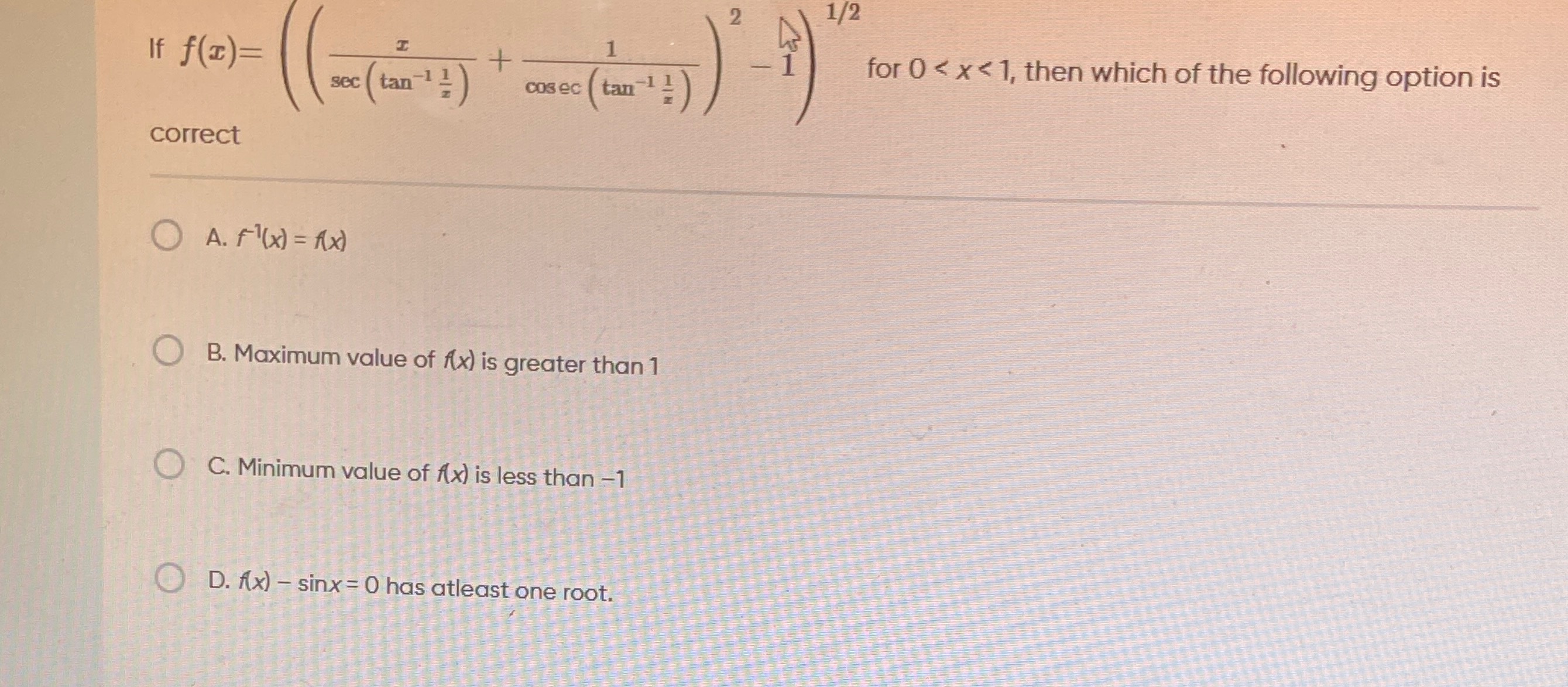Question
Question: If $f(x)=\left(\left(\frac{x}{\sec\left(\tan^{-1}\frac{1}{x}\right)}+\frac{1}{\csc\left(\tan^{-1}\fr...
If f(x)=((sec(tan−1x1)x+csc(tan−1x1)1)2−1)1/2 for 0<x<1, then which of the following option is correct

f−1(x)=f(x)
Maximum value of f(x) is greater than 1
Minimum value of f(x) is less than -1
f(x)−sinx=0 has atleast one root.
A. f−1(x)=f(x)
Solution
The given function is f(x)=((sec(tan−1x1)x+csc(tan−1x1)1)2−1)1/2 for 0<x<1.
Let θ=tan−1x1. Since 0<x<1, x1>1. The range of tan−1y for y>0 is (0,2π). Since x1>1, θ=tan−1x1 is in the interval (4π,2π). In this interval, secθ>0 and cscθ>0. We have tanθ=x1. We can find secθ and cscθ using a right triangle or identities. Using identities: sec2θ=1+tan2θ=1+(x1)2=1+x21=x2x2+1. Since θ∈(4π,2π), secθ>0, so secθ=x2x2+1=∣x∣x2+1. Since 0<x<1, ∣x∣=x. Thus, secθ=xx2+1. csc2θ=1+cot2θ=1+x2. Since θ∈(4π,2π), cscθ>0, so cscθ=1+x2.
Now substitute these into the expression for f(x): sec(tan−1x1)x=secθx=xx2+1x=x2+1x2. csc(tan−1x1)1=cscθ1=x2+11.
The expression inside the square is x2+1x2+x2+11=x2+1x2+1=x2+1.
So, f(x)=((x2+1)2−1)1/2=((x2+1)−1)1/2=(x2)1/2. Since the domain is 0<x<1, x is positive, so (x2)1/2=∣x∣=x. Thus, f(x)=x for 0<x<1.
Now let's evaluate the given options: A. f−1(x)=f(x) The function is f(x)=x for x∈(0,1). The domain of f is (0,1) and the range of f is (0,1). To find the inverse function, let y=f(x)=x. Swap x and y: x=y. So y=x. The domain of f−1 is the range of f, which is (0,1). The range of f−1 is the domain of f, which is (0,1). So, f−1(x)=x for x∈(0,1). Therefore, f−1(x)=f(x) for x∈(0,1). This option is correct.
B. Maximum value of f(x) is greater than 1 f(x)=x for x∈(0,1). The range of f(x) is (0,1). The values of f(x) are always strictly between 0 and 1. The supremum is 1, but it is not attained in the open interval. No value of f(x) is greater than 1. This option is incorrect.
C. Minimum value of f(x) is less than -1 f(x)=x for x∈(0,1). The range of f(x) is (0,1). The values of f(x) are always strictly positive. The infimum is 0, but it is not attained in the open interval. No value of f(x) is less than -1. This option is incorrect.
D. f(x)−sinx=0 has atleast one root. This is equivalent to f(x)=sinx, which is x=sinx for x∈(0,1). Consider the function g(x)=x−sinx. We are looking for a root of g(x) in the interval (0,1). We know that for x>0, sinx<x. To prove this, consider h(x)=x−sinx. h′(x)=1−cosx. For x∈(0,1), 0<x<1<2π, so cosx<1. Thus h′(x)=1−cosx>0 for x∈(0,1). Since h(x) is strictly increasing on (0,1) and h(0)=0−sin0=0, for any x∈(0,1), h(x)>h(0)=0. So x−sinx>0 for all x∈(0,1). The equation x=sinx has no solution in the interval (0,1). This option is incorrect.
The only correct option is A.
